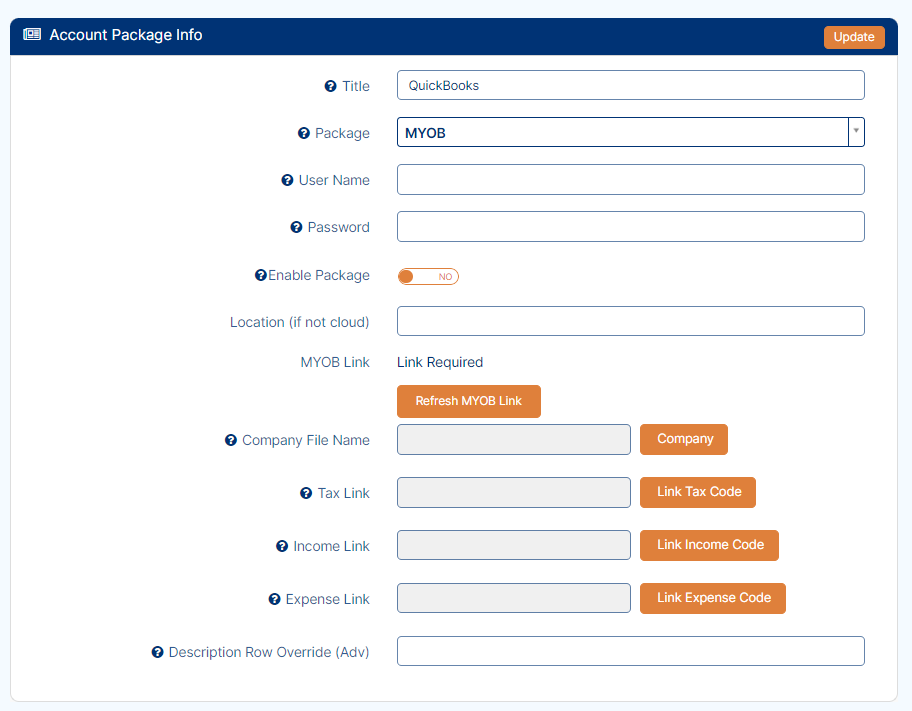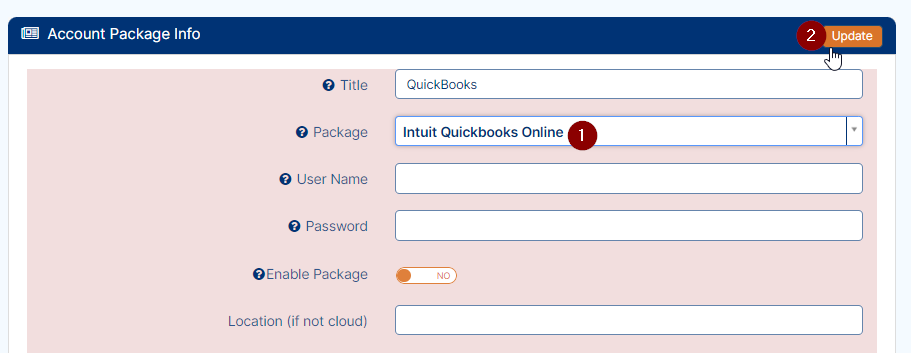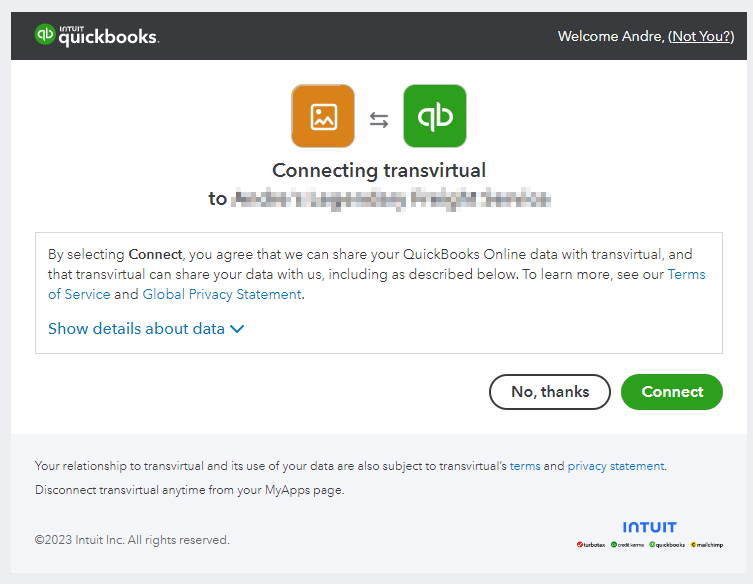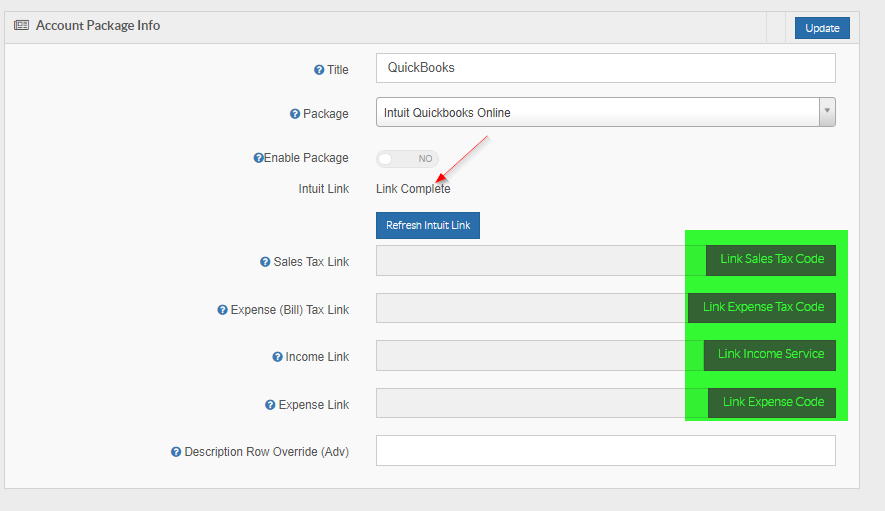Account Packages

This feature requires the Finance Module to be active in TransVirtual
This is a 3-step process:
- Link TransVirtual and your accounting software.
A. MYOB
B. Xero
C. Reckon
D. QuickBooks - Setup an EDI Export invoice rule to send your invoice data across to your accounting software = Invoice EDI Export (transvirtual.com)
- Link customers/agents cards in TransVirtual with those in your accounting software

New menu users should navigate to Finance > Configuration and Setup > 3rd Party Account Links to setup the relevant account package.
Linking to MYOB AccountRight (Cloud)
This integration allows for financial data to transfer to MYOB for accounting purposes and bank reconciliation.

You MUST have an AccountRight MYOB account for this setup - MYOB Essentials does not support integration and can't be linked to TransVirtual.
There are two broad steps:
1. Link TransVirtual to your MYOB account
2. Export your invoices (EDI) to MYOB.
Navigate to Account Packages (Finance > Other Setup > Account Packages)
Select + New Account Package button

(Users of the 2022 navigation update should proceed to Finance > Configuration and Setup > 3rd Party Account Links)
Give your new account package a name, this may just be MYOB if you only run one account package however TransVirtual has the ability to split your invoices across multiple account packages and companies
Click the Create button
Your Account package will start as disabled (highlighted orange) until setup is complete
Select your new account package from the list on the left and then select the relevant account package in this case being MYOB and click Update at the top right
Click the Refresh MYOB Link button
You will be taken to the MYOB web page where you will need to enter the online user login details of an admin user for your account package and presented with a page giving TransVirtual permission to transfer data to your MYOB account.
You will also need to create an offline admin user for TransVirtual also to access your company file. You can do this in your MYOB software as below by going to Setup>User Access
As below select New User, the user name and password will need to be later entered into the TransVirtual for us to access your company file. The
Also deselect the option below for the user to sign on with a my.MYOB account as this will need to be a login just to your company file
Also ensure the new user is given Administrator access
Once complete you can now return to TransVirtual and enter this username and password as below
Now we can select the relevant GL Accounts in MYOB for the invoices to Transfer against. As per below select Link Income Code and Link Expense Code and you will see a list of accounts from your account package and select the relevant code for Customer Invoices/Income and Supplier/Agent Invoices/Expenses
You are now able to toggle the Enable Package to Yes then click the Update button
Now navigate to Export Invoices (EDI > Data Export > Invoices) where we will need to setup conditions surrounding the use of the Link to MYOB
Select New Rule from the center of the page and create a name for your rule, for a simple setup this can just be MYOB and select the AccountPackage option from the Export Framework dropdown as below

(Users of the 2022 navigation update should proceed to Import/Export > Data Export > Invoices)
Now we need to set a trigger for these invoices to transfer to MYOB
In the data filter section you have a rule builder as below, if you choose Invoice State from the dropdown and select Next, then select Equal from the drop down and click Next, then choose Approved and Locked from the dropdown and select Add Rule
Now we are ready to enable the rule
Linking to Xero
The Xero integration allows for financial data to transfer to Xero for accounting purposes and bank reconciliation.
There are two broad steps:
1. Link TransVirtual to your account package
2. Export your invoices (EDI) to the account package.
Navigate to Account Packages (Finance > Other Setup > Account Packages)
Select + New Account Package button

(Users of the 2022 navigation update should proceed to Finance > Configuration and Setup > 3rd Party Account Links)
Give your new account package a name, this may just be Xero if you only run one account package however TransVirtual has the ability to split your invoices across multiple account packages and companies
Click the Create button
Your Account package will start as disabled (highlighted orange) until setup is complete
Select your new account package from the list on the left and then select the relevant account package in this case being Xero and click Update at the top right
Click the Refresh XERO Link button
You will be taken to the Xero web page where you will need to enter the login details of an admin user for your account package and presented with a page giving TransVirtual permission to transfer data to your Xero account.
Once complete you can now return to TransVirtual where we can select the relevant GL Accounts in Xero for the invoices to Transfer against. As per below select Link Income Code and Link Expense Code and you will see a list of accounts from your account package and select the relevant code for Customer Invoices/Income and Supplier/Agent Invoices/Expenses
You are now able to toggle the Enable Package to Yes then click the Update button
Now navigate to Export Invoices (EDI > Data Export > Invoices) where we will need to setup conditions surrounding the use of the Link to Xero
Select New Rule from the center of the page and create a name for your rule, for a simple setup this can just be Xero and select the AccountPackage option from the Export Framework dropdown as below

(Users of the 2022 navigation update should proceed to Import/Export > Data Export Invoices)
Now we need to set a trigger for these invoices to transfer to Xero
In the data filter section you have a rule builder as below, if you choose Invoice State from the dropdown and select Next, then select Equal from the drop down and click Next, then choose Approved and Locked from the dropdown and select Add Rule
Now we are ready to enable the rule
Additional Information
Xero does not accept future dated invoices
Linking to Reckon (Local Host)
Requires the use of Zed Axis installed on your own FTP server and Reckon to be hosted in your local server (not online/cloud)

Requires a few hours of support from TransVirtual to setup exports - ask us for help on this if needed
Requires setup from Zed Axis/3rd Party for configuration
Linking to Quickbooks
To set this up, navigate to either Finance > Other Setup > Account Packages OR Finance > Configuration and Setup > 3rd Party Account Links.
Here you will have the ability to add/create a new Account Package - simply click New Account Package and name accordingly:

Here you will have the ability to add/create a new Account Package - simply click New Account Package and name accordingly:
Then:
This will add a new line into your Account Package Listing as per the below:
Click on the newly created package and the settings for it will appear on the right-hand side:

From here, select the Package type as QuickBooks then click Update at the top:

Next, click on Refresh Intuit Link:
You will then be taken to a login page where you should enter your login details for QuickBooks:
Enter your details and Sign In.
You will then be presented with a screen like the below:

You will then be presented with a screen like the below:
Click Connect to link your TransVirtual account to your QuickBooks account.
You will then be taken back to TransVirtual where you can then link your Sales, Expense, Income and Expense codes as required:

 If the Intuit Link says Link Complete that means you have successfully linked to QuickBooks!
If the Intuit Link says Link Complete that means you have successfully linked to QuickBooks!
Like with other platforms such as MYOB, Xero, once you have linked to your Accounts Package you need to setup an EDI export rule to send invoice data across to QuickBooks.
This help link will assist with this part: Invoice EDI Export (transvirtual.com)
The above link provides an example for Xero but QuickBooks is exactly the same - you would just need to change your EDI rule name to reflect QuickBooks instead.
The last part of this setup is detailed in the below section of this article titled "Linking Agents/Customers to Accounts package" - from there you are ready to send invoice data across to QuickBooks.
This help link will assist with this part: Invoice EDI Export (transvirtual.com)
The above link provides an example for Xero but QuickBooks is exactly the same - you would just need to change your EDI rule name to reflect QuickBooks instead.
The last part of this setup is detailed in the below section of this article titled "Linking Agents/Customers to Accounts package" - from there you are ready to send invoice data across to QuickBooks.
Linking Agents/Customers to Accounts Package
In this article we will show you how to link agents and customers to your accounts package; MYOB/Xero. This is useful if you wish to have your TransVirtual generated invoices for your customers/agents appear in your accounting software.
1. Open the Card File
Home>Card Files> Agent/Supplier List or Customer List
 (Users of the 2022 navigation update should proceed to Transport > Configuration And Setup > Card Files (Customer/Suppliers/Staff))
(Users of the 2022 navigation update should proceed to Transport > Configuration And Setup > Card Files (Customer/Suppliers/Staff))
2. Click the Finance tab
3. Link The Card File. To do so, you will need to first double-click the Accounts package field and link this customer/agent to that package:
After this has been done, simply click the Link button to find the corresponding agent or customer name from within your accounts package:
Extra Information
If needed, there is the ability in TransVirtual to modify the invoice data descriptions sent across to your linked Accounts Package.
To do this and for further information on the fields available, click on the helper icon listed against the below setting:

To do this and for further information on the fields available, click on the helper icon listed against the below setting:
All that is required is to type the fields required and/or any free text you wish to also enter, like the below as an example:
When an invoice sends across to your linked Accounts Package now (below image is for Xero), the Invoice would look like this:
You can see that the invoice is split up with separate lines per consignment on the invoice - handy if something you wish to utilize.
This same concept (splitting up consignments uniquely per line) also works with MYOB, and below is what it would look like if done to MYOB:
Multiple Company Files/Organisations in an Accounting Package
In MYOB and Xero (for example), you are able to setup multiple Company Files/Organisations which are basically just the different businesses that you own or run. The purpose of this is to allow you to control all of your finances across all divisions of your business within the one accounting package account (one Xero account or one MYOB account).
TransVirtual allows you the ability to connect to all of your different Company Files/Organisations.
TransVirtual allows you the ability to connect to all of your different Company Files/Organisations.
To do this, simply create a new Account Package per each Company File/Organisation you wish to send data to - the below as an example:
Once created, if doing for Xero for example, simply click the Refresh Xero link button against each account package and choose the organisation that applies to that account package:
Each account package should have a unique selection.
Once done, you then have the ability to attach customers/agents to a code across all available from all account package company files/organisations.
Once done, you then have the ability to attach customers/agents to a code across all available from all account package company files/organisations.
Related Articles
Enable/Disable Modules - Account Level
Enable/Disable Add-On Modules via the Web Portal Go to the Rates and Modules page (Settings > TransVirtual Account > Rates and Modules) Select the module you'd like to enable/disable and click the slider to activate (or deactivate). The module is now ...Finance/Invoice Setup Process
TransVirtual has an optional add-on Finance module that allows you to add pricing to consignments and invoice out consignments to customers; as well as send these invoices across to your accounting software (Myob or Xero) so that you can keep track ...GST Rounding
The invoice tax total isn’t exactly 10% of the invoice base total. Why? This isn’t a mistake of the software but a common misconception between what users expect to see on an invoice and what software systems prefer to do when exchanging data. ...Invoice EDI Export
Invoice Export Setup In TransVirtual you can setup an EDI (Electronic Data Interchange) that automatically sends PDF, Excel, CSV (etc.) Invoice files to a Customer or Agent, based on specific situations. So, when an Invoice is Approved and Locked you ...Data Exports
Creating a Data Export Before we can start creating the export we need to analyze the issue we are trying to solve. At its simplest you can work through a few easy questions to get you started: When would you like to export the data? To run a data ...